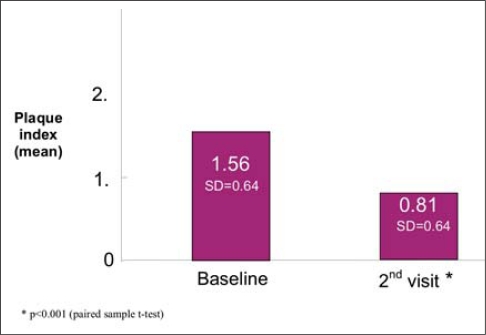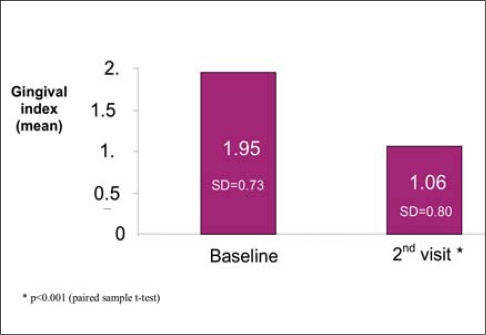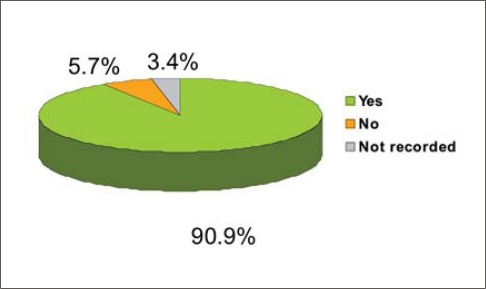Summary
Aims
To determine whether the oral health benefits of recommending twice daily brushing and rinsing with an essential oil mouthrinse (EOM) are perceived and measurable by dentists and also perceived by their patients at a 3-month recall visit.
Methods
This is a monadic, open label, uncontrolled study involving 766 generally healthy Italian subjects aged 19–66 years, with mild to moderate levels of gingivitis, no pockets of more than 4 mm, and at least 20 scorable teeth. Eight dentists scored subjects for plaque and gingivitis at baseline and at 90 days using simplified 4-point plaque and gingivitis indices. All subjects brushed twice daily, immediately followed by rinsing for 30 sec with 20 ml of an essential oil mouthrinse (Listerine®).
Results
735 subjects completed the study (95.9%). Average score reductions were 51.9% and 45.7% for plaque and gingivitis, respectively. About 62% and 70% were judged by the dentists as improved for plaque control and gingival health. 85% of subjects judged the EOM as efficacious.
Conclusion
The oral health benefits of brushing and rinsing twice daily with an essential oil mouthrinse are perceived by patients and professionals alike and measurable by dentists at a 3-month recall visit.
Keywords: oral hygiene, gingivitis, mouthrinses, essential oils
Introduction
Over the last few decades it has become apparent that regular toothbrushing alone is not sufficient for plaque and gingivitis control and that flossing on a regular basis should be part of an optimal standard regimen for plaque control (1). However it has also been widely recognised that the full potential of mechanical means of plaque control is seldom achieved. This is primarily through lack of sufficient motivation, manual dexterity or time for the individual to maintain an acceptable standard of mechanical oral hygiene routine (2,3).
In the Western world the shortcomings of mechanical oral hygiene are demonstrated by a high prevalence of periodontal diseases (e.g. 40–45% moderate and 5–10% severe cases in UK adults) and by the presence of visible plaque and dental calculus in the large majority of the adult population (about 70% in UK adults) (4).
New evidence based approaches to improving oral hygiene outcomes are therefore needed. It has been proposed that this can be achieved by encouraging all individuals to adopt daily rinsing with an antimicrobial rinse as an adjunct to mechanical plaque control practices (3,5). However, only a few commercially available mouthrinses have been extensively tested and have shown convincing evidence of their efficacy. Among these, chlorhexidine- and essential oil-containing mouthrinses have been clinically proven to provide long-term anti-plaque and anti-gingivitis efficacy (6–14).
Chlorhexidine-containing mouthrinses are known to produce a high rate of tooth staining and taste disturbances among users, hence the tendency among professionals to recommend these for short term treatment needs only (10). On the other hand, a mouthrinse containing essential oils, such menthol, thymol, methyl salicilate, eucalyptol has the potential to meet long-term preventive objectives, provided the patients’ motivation is also maintained in the long term.
Here it is proposed that the long term patient motivation to daily rinsing can be influenced by whether the patient can perceive the efficacy of the essential oil mouthrinse (EOM). Moreover, the clinician’s motivation to recommend a significant modification of the patients’ oral hygiene routine may depend on not only perceived but also measurable treatment performance by the dental professional. This study evaluated perceived treatment performance by patients and professionals, as well as measurable performance by the dentists, shortly after the recommendation of daily EOM use was given.
Materials and methods
The study design was approved by the “Sapienza” University Ethic Committee and was found to conform to the requirements of the “Declaration of Helsinki” as adopted by the 18th World Medical Assembly in 1964 and subsequently revised (15). Subjects were recruited at 8 university-based dental clinics across Italy. In order to be accepted onto the study all volunteers had to be at least 18 years old, give written informed consent, be generally healthy, present mild to moderate levels of gingivitis with no periodontal pockets of more that 4 mm probing depth, and a minimum of 20 scorable teeth. Enrolled subjects received scaling and polishing and were asked to refrain from taking non-essential medication and to avoid using any type of oral antiseptics for at least 30 days prior to the study start. A dentist in each clinic performed plaque and gingival health assessments at baseline and at 90 days. Each sextant was scored using a simplified 4-point plaque and gingival health index (16,17) as follows:
- - Plaque Index
- 0 = absence of plaque
- 1 = mild, separate spots or a discontinuous band of plaque at the gingival margin
- 2 = moderate, homogeneous band of at the gingival margin covering less than a third of tooth surface
- 3 = heavy, plaque covering more than a third of tooth surface
- - Gingival Index
- 0 = absence of inflammation
- 1 = mild, slight change of superficial texture, slight oedema
- 2 = moderate, reddening, oedema, translucent gingiva
- 3 = severe, marked reddening, oedema.
At baseline all subjects were shown and instructed to brush twice daily using a modified Bass technique and to rinse with 20 ml of an EOM (Listerine® Difesa denti e gengive; Johnson & Johnson, Santa Palomba-Pomezia, Italy) immediately after brushing. At the final 90-day visit all subjects were asked to fill out a questionnaire. A paired sample t-test was used to detect significant differences in plaque and gingivitis levels at baseline and at the 90-day visit. The significance level was set at P<0.05.
Results
A total of 766 subjects were accepted onto the study and 735 subjects (95.9%) were exited from the study having completed it. The age range of participating subjects was 19–66 years and each of the eight study centres enrolled between 50 and 118 subjects (Table 1). When compared to baseline, the 90-day average plaque scores had decreased from 1.56 to 0.81, representing a 51.9% reduction. Gingival inflammation scores had decreased from to 1.95 to 1.06, representing a 45.7% reduction. Both changes reached high statistical significance (P<0.001) (Figs. 1 and 2). The dentists judged 62.5 % of subjects as improved for plaque control (21.1% greatly improved and 51.4% fairly improved). With respect to gingivitis levels, 69.8% of subjects were judged as improved (12.7% greatly improved and 57.1% fairly improved). 84.9% of participating subjects judged the product as efficacious (11.0% very efficacious, 48.2 % efficacious and 25.7% fairly efficacious). One interesting data comes from the level of compliance all patients showed in terms of fulfilling all of the requirements for proper completion of the study (Fig. 3).
Table 1.
Study population.
| Number of subjects | |
|---|---|
| Subjects enrolled at baseline | 766 |
| Subjects not returned to 2nd visit (after 90 days) | 31 |
| Subjects examined at baseline and after 90 days | 735 |
| - male | 380 (51.7%) |
| - female | 355 (48.3%) |
| - mean age (±SD), years | 30.5 (10.3) |
| - age range, years | 18–66 |
Figure 1.
Plaque index at baseline and after 90 days of a twice/day use of an EOM as adjunct to brushing.
Figure 2.
Gingival index at baseline and after 90 days of a twice/day use of an EOM as adjunct to brushing.
Figure 3.
Compliance of patients enrolled and which completed the study in terms of respect of the protocol suggested. (Yes: compliance present; No: compliance absent; Not recorded: data not recorded).
Discussion
Daily rinsing with proven antibacterial agents may represent a universally applicable method of supplementing the benefits of mechanical plaque control. In fact rinsing does not pose any manual dexterity challenges and can deliver anti-plaque benefits to hard to reach areas of the mouth more reliably than regular brushing alone or brushing and flossing (1,3,5,10).
However sufficient motivation will be required for individuals to modify their long established oral hygiene habits and add rinsing with an antimicrobial rinse to their daily routine. It can be hypothesised that for a newly recommended regimen to be accepted by patients and to be sufficiently motivating to the patients its benefits should be perceived by them reasonably soon after receiving the professional recommendation.
It is reasonable to expect that dentists would be more inclined to recommend to their patients that they should alter their well-established oral hygiene routine if the professionals themselves could unmistakably perceive and measure the clinical performance of the recommended regimen.
This study aimed at determining whether the widely reported clinical benefits for daily use EOM in randomised controlled trials can translate into perceived and measurable performance in a dental practice setting. For the purpose of the study, it was critically important for the volunteers to be recruited among patients in the care of the clinicians acting as their clinical examiners on the study. The clinician-patient interaction is in fact the necessary context for the motivational boost to take effect on both sides of the relationship and for the treatment efficacy perception to play its proposed role.
The importance of basing the study on an authentic patient-clinician relationship also explains the exclusion of a placebo treatment group from the study design. An additional consideration was the fact that a placebo group would only have been useful to confirm the product’s efficacy, which was clearly outside the scope of the study as it has already been largely demonstrated in multiple long term randomised clinical trials (6–9,11,12).
Open label, uncontrolled, monadic studies offer the advantage that a large number of observations can be taken within the context of every day general practice (18). For this purpose all assessments in this study were performed by a representative group of practicing dentists, who were also the actual caregivers to participating subjects.
There was a three-month period between baseline and final examination, rather than the more commonly adopted six-month review period. This short time interval was selected to ensure that patients were re-examined while they were still likely to be practicing the newly recommended habit of rinsing twice daily with EOM in addition to brushing. In fact only 5.7% of participating subjects were found to be non-compliant at the end of the 3-month period. Both the clinicians’ and the patients’ motivation will be reinforced further if the final positive results can be clearly attributed to the recommendations given at the first visit.
Highly significant and substantial reductions in plaque and gingivitis levels were measured by the dentists in this study. Being an open label study the clinician judgement would have been undoubtedly conditioned by expectations of improved oral conditions at recall. Further studies will need to establish whether the large effect size measured by the professionals in this study was due more to the underlying product efficacy or to product performance expectations. In conclusion, the results of this study indicated that shortly after a professional recommendation to brush and rinse twice daily with an EOM, the oral health benefits will be perceived by patients and dentists, and will measurable by the professionals themselves.
Acknowledgments
Mouthrinses and single-use equipment used to assess plaque and gingivitis indexes were kindly provided by Johnson & Johnson S.p.A (Santa Palomba-Pomezia, Italy).
Footnotes
Source of support: Johnson & Johnson (Santa Palomba-Pomezia, Italy) kindly provided mouthrinses and single-use equipment used to assess plaque and gingivitis indexes.
References
- 1.Hancock EB, Newel DH. Preventive strategies and supportive treatment. Periodontol 2000. 2001;25:59–76. doi: 10.1034/j.1600-0757.2001.22250105.x. [DOI] [PubMed] [Google Scholar]
- 2.Jepsen S. The role of manual toothbrushes in effective plaque control: advantages and limitations. In: Lang NP, Attström R, Löe H, editors. Proceedings of the European Workshop on Mechanical Plaque Control. London: Quintessence Publishing Co., Ltd; 1998. pp. 121–37. [Google Scholar]
- 3.Ciancio S. Improving oral health: current considerations. J Clin Periodontol. 2003;30(Suppl 5):4–6. doi: 10.1034/j.1600-051x.30.s5.2.x. [DOI] [PubMed] [Google Scholar]
- 4.Morris AJ, Steele J, White DA. The oral cleanliness and periodontal health of UK adults in 1998. Br Dent J. 2001;191:186–92. doi: 10.1038/sj.bdj.4801135. [DOI] [PubMed] [Google Scholar]
- 5.Santos A. Evidence-based control of plaque and gingivitis. J Clin Periodontol. 2003;30(Suppl 5):13–6. doi: 10.1034/j.1600-051x.30.s5.5.x. [DOI] [PubMed] [Google Scholar]
- 6.Overholser CD, Meiller TF, De Paola LG, Minah GE, Niehaus C. Comparative effects of 2 chemotherapeutic mouthrinses on the development of supragingival dental plaque and gingivitis. J Clin Periodontol. 1990;17:575–9. [PubMed] [Google Scholar]
- 7.Charles CH, Sharma NC, Galustians HJ, Qaqish JG, McGuire JA, Vincent JW. Comparative efficacy of an antiseptic mouthrinse and an antiplaque/antigingivitis dentifrice: a six-month clinical trial. J Am Dent Assoc. 2001;132:670–5. doi: 10.14219/jada.archive.2001.0245. [DOI] [PubMed] [Google Scholar]
- 8.Sharma NC, Charles CH, Qaqish JG, Galustians HJ, Zhao Q, Kumar LD. Comparative effectiveness of an essential oil mouthrinse and dental floss in controlling interproximal gingivitis and plaque. Am J Dent. 2002;15:351–5. [PubMed] [Google Scholar]
- 9.Bauroth K, Charles CH, Mankodi SM, Simmons K, Zhao Q, Kumar LD. The efficacy of an essential oil antiseptic mouthrinse vs. dental floss in controlling interproximal gingivitis: a comparative study. J Am Dent Assoc. 2003;134:359–65. doi: 10.14219/jada.archive.2003.0167. [DOI] [PubMed] [Google Scholar]
- 10.Addy M, Moran J. Chemical supragingival plaque control. In: Lindhe J, Karring T, Lang NP, editors. Clinical Periodontology and Implant Dentistry. 5th edn. Oxford: Blackwell Publishing; 2008. pp. 734–57. [Google Scholar]
- 11.Sharma NC, Charles CH, Lynch MC, Qaqish JG, McGuire JA, Galustians HJ, et al. Adjunctive benefit of an essential oil-containing mouthrinse in reducing plaque and gingivitis in patients who brush and floss regularly: a six-month study. J Am Dent Assoc. 2004;135:496–504. doi: 10.14219/jada.archive.2004.0217. [DOI] [PubMed] [Google Scholar]
- 12.Charles CH, Mostler KM, Bartels LL, Mankodi SM. Comparative antiplaque and antigingivitis effectiveness of a chlorhexidine and an essential oil mouthrinse: 6-month clinical trial. J Clin Periodontol. 2004;31:878–84. doi: 10.1111/j.1600-051X.2004.00578.x. [DOI] [PubMed] [Google Scholar]
- 13.Patel RM, Malaki Z. The effect of a mouthrinse containing essential oils on dental plaque and gingivitis. Evid Based Dent. 2008;9:18–9. doi: 10.1038/sj.ebd.6400566. [DOI] [PubMed] [Google Scholar]
- 14.Pizzo G, La Cara M, Licata ME, Pizzo I, D’Angelo M. The effects of an essential oil and an amine fluoride/stannous fluoride mouthrinse on supragingival plaque regrowth. J Periodontol. 2008;79:1177–83. doi: 10.1902/jop.2008.070583. [DOI] [PubMed] [Google Scholar]
- 15.The World Medical Association Policy: World Medical Association Declaration of Helsinki. Available at: http://www.wma.net/en/30publications/10policies/b3/index.html. Accessed August 31, 2010.
- 16.Silness J, Loe H. Periodontal disease in pregnancy. II. Correlation between oral hygiene and periodontal condition. Acta Odontol Scand. 1964;22:121–35. doi: 10.3109/00016356408993968. [DOI] [PubMed] [Google Scholar]
- 17.Silness J, Loe H. Periodontal disease in pregnancy. III. Response to local treatment. Acta Odontol Scand. 1964;24:747–59. doi: 10.3109/00016356609028739. [DOI] [PubMed] [Google Scholar]
- 18.Warren PR, Ray TS, Cugini M, Chater BV. A practice-based study of a power toothbrush: assessment of effectiveness and acceptance. J Am Dent Assoc. 2000;131:389–94. doi: 10.14219/jada.archive.2000.0183. [DOI] [PubMed] [Google Scholar]





